The chain of weapon effectiveness versus bosses can be a tricky thing in Mega Man games. Sometimes it makes perfect, logical sense; other times, not so much. For example, Mega Man 6. How do you determine what the Yamato Spear is good against? It’s basically a pointy stick that embodies ancient Japan, which isn’t really a weak point, thematically speaking, against any of the bosses that appear in the game… so they arbitrarily decided to make it effective against Knight Man. Well, I hope it was arbitrary. Otherwise there’s a little cultural snobbery happening there.
Mega Man does its best, within its limited means. The entire chain of weaknesses draws its inspiration from rock-paper-scissors, so of course Guts Man’s Super Arm – which allows you to heave rocks at enemies – is good against Cut Man’s boomerang-like scissors. Alas, Mega Man lacks a Paper Man; and even Wood Man (who could theoretically be pulped into paper) doesn’t appear until Mega Man 2. So who does the Rolling Cutter work against? Elec Man.
“But why would scissors – which are probably made of metal! – be good against electricity?” you wonder. Well, most likely they’re not. But electricity is conducted by cables, and indeed the backgrounds of Elec Man’s stage frequently depict cables, wires, and other electrical conduits running between the various mechanical devices embedded in the walls. You’re not cutting Elec Man’s electricity; you’re cutting his cables. Tokuro Fujiwara, Keiji Inafune, and Akira Kitamura (and their team) put some thought into how the game’s mechanics fit together, and if you stop and think logically about it, you can actually puzzle out at least some portions of the ideal level sequence without the need to experiment.
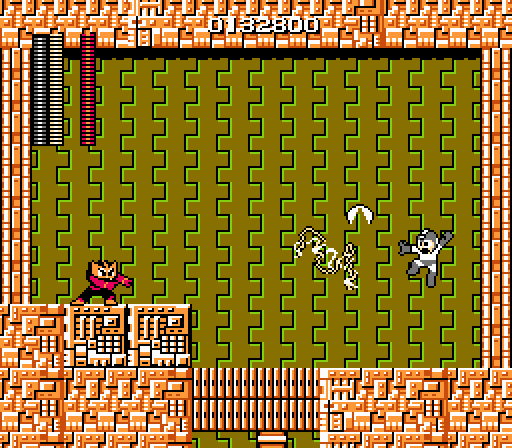
As for Elec Man himself, he holds the crown for being the single most difficult Robot Master in the game. The only other boss who hits as hard as he does is Ice Man – three hits of their weapons will shatter Mega Man – but Elec Man’s behavior makes him nearly impossible to defeat unless you have the Rolling Cutter. Air Man has nothing on this guy.
The challenge that Elec Man poses comes from his erratic movements. He runs quickly back and forth in his room, pausing only to toss bolts of electricity at you. The Thunder Beam travels in a dense sine wave pattern that effectively makes its hit box about 50% taller than Mega Man and twice as wide. You can jump over it with perfect timing, but it moves quickly and Elec Man likes to throw them in rapid succession. Worse, he also likes to get right up in your face, which introduces the hazard of possible collisions while also greatly reducing the amount of time you have to react to his attacks.
Elec Man’s level reflects the boss’ high difficulty level. It’s a grueling, dangerous stage from start to finish. Top that off with a boss who can destroy you in seconds and you have a stage that clearly communicates the fact that it’s meant for experienced players, not as a first-time venture.
That being said, Elec Man’s stage still does a pretty respectable job of cluing you in to the tool you’ll need for victory. As noted before, the first screen you face places you at the bottom of a shaft lined by staggered platforms patrolled by Spines. The most effective weapon against Spines? The Rolling Cutter.
You can get through here without the Rolling Cutter, but the only other weapon that kills Spines is the Hyper Bomb. Otherwise, the most you can do is stun them for a few seconds – basically long enough to hop up to the platform, perform a tiny half-jump to bring you high enough to shoot the next Spine, then jump across to the next platform. The low height of the ceilings here requires perfect control so that you don’t bump your head and fall when you make the leap.
Without the Spines, though, the pressure disappears. The Rolling Cutter transforms this screen from nerve-wracking to breezy.
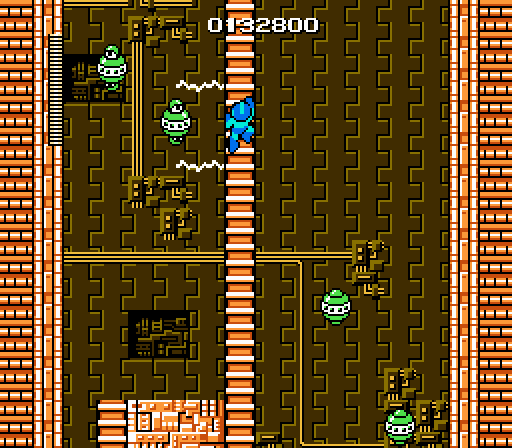
Likewise, the Rolling Cutter proves invaluable against these guys, too. They appear from the top left and bottom right in two packs of three and drift vertically toward the opposite end of the screen. When they pull even with Mega Man, they unleash a pair of electrical beams above and below him. If you have very, very good nerves, you can wait these out, but the slightest movement brings disaster – and sometimes the beams will hit you even if you think you’re situated safely (Mega Man is a bit glitchy).
Should one of those energy beams hit you, you’ll lose your grip on the ladder and plummet to the screen below. Given that Elec Man’s entire stage is one long ascent (with only two short interstices that scroll horizontally for a short ways), you definitely want to avoid losing that progress. Handily, the Rolling Cutter’s relatively slow movement and vertical drift make it great for taking out these guys. The Thunder Beam is even better, but obviously you won’t have that your first time through the stage.
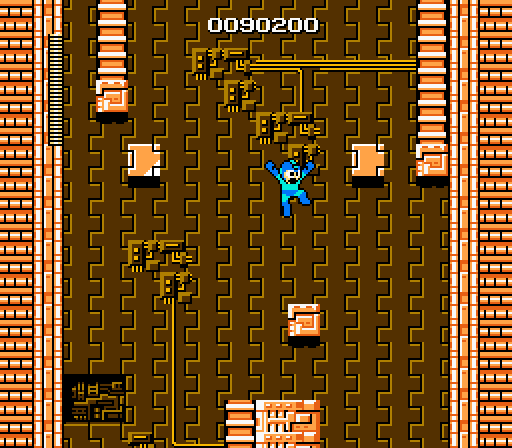
At the pinnacle of the first leg of the ascent, past the enemies and ladders and beam emitters, you’ll reach Mega Man‘s indigenous, trademark act of hatred: Vanishing blocks.
Vanishing blocks – or perhaps more correctly, reappearing blocks – are single-block platforms that materialize and disappear in a regular, consistent patterns. Their predictability is your only advantage when dealing with them. If you can get the timing down and figure out how and where you should be jumping to, you can generally make it through these gauntlets with little trouble.
Unfortunately, they require excellent timing on your part, especially for instances in which you have to leap upward through the space a block will materialize in as it’s about to appear. If you mistime it, the block will phase in as you pass through its space, pushing you to one side or the other. This happens quickly and leaves little time for correcting your leap, and in a worst-case scenario (such as here, at the top of a tall shaft) it can push you into a pit, either killing you instantly in a vertically scrolling situation or just plain killing you if it’s a bottomless pit. Disappearing blocks are the worst.
The first instance isn’t so bad, but the second screen (which appears immediately above this one) forces you to dash across the blocks as they appear side-by-side (and quickly phase out) above a gaping chasm.
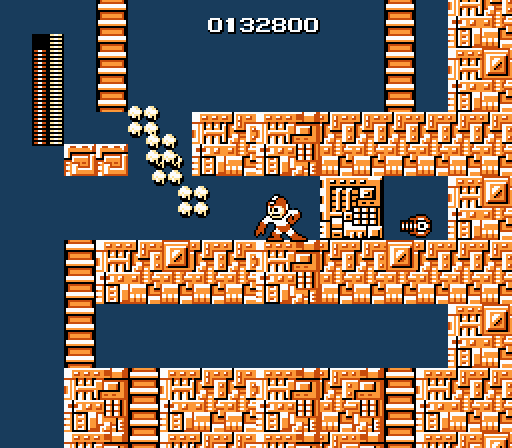
Eventually – once you reach the top of the first shaft and survive a tense gauntlet of tiny platforms leading to the second half of Elec Man’s level – you’ll reach the infamous Magnet Beam.
The Magnet Beam appears locked in behind a trio of rocks. The only way to reach it is to toss the rocks aside with the Super Arm or evaporate them with the Thunder Beam. Of course, what makes this tricky is that the first time through Elec Man’s stage, you won’t have the Thunder Beam. And those early trundles over the pits in Guts Man’s stage require a deft touch and good timing, and are far more easily bypassed with the Magnet Beam. So, the conundrum here: The Magnet Beam is extremely valuable, but in order to claim it you need to clear a high barrier to difficulty.
This isn’t quite on par with certain RPGs that give you an ultimate super weapon only after you defeat the most powerful enemy in the game (thereby negating the need for your prize), but it definitely comes from the same school of cruelty. That being said, the situation isn’t as backward as it would seem.
Experienced Mega Man fans tend to view the games in terms of simply clearing stages as efficiently as possible, then moving along to the next. And that’s fine. But your first time through any Mega Man game generally involves a fair amount of trial-and-error – not in a bad, obtuse way, but rather in a exploratory sense as you get a feel for the new mechanics, the unique hazards of each stage, and try to see which Robot Master you can fell without exploring the weakness chain. That fact held doubly true back in 1987, when Mega Man‘s any-stage-you-like approach was new and unfamiliar. Games that played like this were still fresh to the world, and certainly one that combined platform shooting mechanics and semi-nonlinearity demanded a great deal of experimentation from players.
Mega Man lacks a password feature or any persistence once you shut down the system. You weren’t meant to complete the game your first time through. As with nearly all games of this era, the idea behind Mega Man was that you’d play it a bit at a time, and as you went you’d familiarize yourself with its rules, the level layouts, and the behavior of enemies. Each time you played, you’d do a little better than the last until you could finally finish the game.
In that context, the Magnet Beam was there to intrigue. A first-time player wasn’t likely to simply sail on past it and reach Dr. Wily’s lair without it, because you would have played through Elec Man’s stage many, many times as you became familiar with the game. Every time you passed the Magnet Beam, you’d see it and wonder about it. Eventually, you’d experiment with the weapons that could break the walls barricading it and figure out how to claim it as your own. To that point, Mega Man is the only one of the original NES Mega Man trilogy to allow you to return to completed stages. In the course of playing, you’d have eventually claimed the Thunder Beam and, in using it, noticed that it could break the blocks that the Super Arm lifts. Or you’d have mastered the trundles in Guts Man’s stage and figured out the mysterious Super Arm. At some point, one way or another, you’d have unlocked the Magnet Beam. And once you’d done so, you’d have realized its value and made a point of claiming it in subsequent plays.
At least, speaking as someone who played through Mega Man when it was still the only game in the series, that was my experience.
The Magnet Beam setup isn’t without its failings – it can be missed – but I think those issues are more pronounced in the age of save states, where even official reissues of the game don’t require as much experimentation and dedication as the old NES cart did. Still, it’s important to keep in mind the era into which Mega Man came into the world. Its contemporaries were things like Milon’s Secret Castle, Castlevania II, Zelda II, and The Goonies, games where secrets were completely invisible and hidden and required pure luck or stubborn persistence to solve. Even Super Mario Bros. 2 (USA) demanded memorization and luck to find all the hidden Mushrooms and Warp Zones. By contrast, this is the solitary hidden secret in Mega Man – and it’s not even hidden, just blocked off!
Mega Man feels like a standard-bearer for transparent game design. While it wasn’t perfect (seriously, the Super Arm took me ages to figure out), the nuances of Mega Man‘s action came from the interactions of powers with the game world and the enemies within it. Nothing was tucked away or demanded chance or blind luck. While it wasn’t perfect, it was part of an important late-’80s trend of giving action games greater depth without compromising the integrity and fairness of their design.
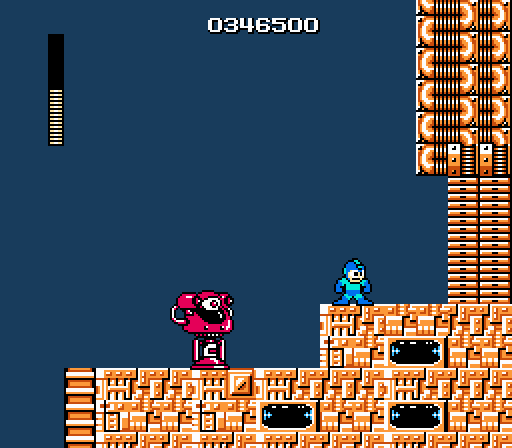
Whether or not you pick up the Magnet Beam, you still have to deal with this guy, who proves that the developers hadn’t entirely ironed out the random luck from the game. While you have just enough time to scramble up the ladder at the lower left and fake the Big Eye out with a short hop (causing it to jump high enough that you can run beneath it), if you don’t know that trick you’re likely to just cling to the ladder and hope he goes sailing over your head as he jumps off the edge. And sometimes he does! But the ladder doesn’t register as solid for enemies, so if he passes through the ladder, he’ll smack into your head as he falls, damaging Mega Man and knocking you to the previous screen… which means you have to climb up and deal with him again.
And it doesn’t get easier once you enter the final antechamber to Elec Man’s room. You continue ascending – the only antechambers in the entire game in which you have to move upward – climbing a two-screen-high ladder surrounded by beam emitters that operate at close quarters on tight timing. You can make it to the top (and the deadly battle with Elec Man) if you move patiently… but if you screw up, you’ll plummet and have to make the climb again.
Definitely not a stage for beginners.
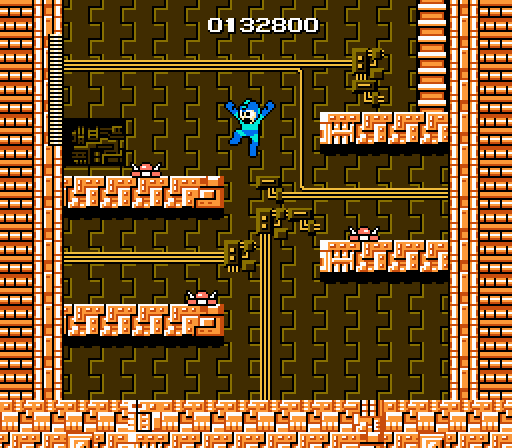
If you think Elec Man is the single most difficult robot master in the game, I can’t wait to see what you think of Fire Man, whose relentless barrages help ensure that if you make it to the final Wily battle at all, it’ll be with only a sliver of life. He remains difficult to face even when you have his weakness while Elec Man becomes more of a road bump at the end.
> To that point, Mega Man is the only one of the NES Mega Man titles to allow you to return to completed stages.
No, 4, 5, and 6 also do that. So basically, anytime it would be possible to clear a stage but leave something behind, you can go back and get it. It’s quite considerate of the developers, really.
That’s an interesting point, though, about experimenting with different strategies and discovering how to get the Magnet Beam and why you’d want it even if it wasn’t required, before you even make it to Dr. Wily’s castle. I guess in 1987, a lot of people’s impressions of how video games were supposed to work still came from arcade games where you couldn’t actually win, you’d just compete for high scores (which itself was really a holdover from pinball.) There were a lot of games where the average player was clearly not intended to ever make it to the end (Mike Tyson’s Punch-Out probably being the canonical example there,) and the “how far can you make it” mentality in combination with lack of the capacity to save your game meant that the first time you played, you weren’t really even trying to get to the end, you were just trying to figure out how the game worked, and once you understood enough about it, then you could figure out the optimal strategy and storm the castle.
And in the 80s, games were made under such restrictive technical limitations that there wasn’t room to create graphics just for extraneous details. If it was visible, it had to be significant, and in that context, just the fact that the Magnet Beam looks different from all the other items is kind of saying “yo dude, you should care about what this thing is and how to get to it.” (The same applies to the one-of-a-kind item in the fourth Dr. Wily level. That one may not be strictly necessary to pick up, but you’d have to be pretty masochistic to skip it, since it fully refills your life and all your weapons, right when you’re likely to be running low, and before you have to fight 5 boss battles in a row.)
Compare that to something like Skyrim, or the later GTA games, where they’ve painstakingly recreated all the trivial background details of an urban environment, and anything that doesn’t look important probably isn’t, so if there’s some critically important item the player absolutely must take with them, it needs to be explicitly pointed out, whether it be through dialogue, or NPC behaviour (like the Dachora and Etecoons in Super Metroid,) or just telling the player But Thou Must until they take the item and not letting them drop it. So the Magnet Beam isn’t badly designed, it’s just an example of an obsolete design pattern that doesn’t really work with how games are designed today.
Yeah, sorry, I’d corrected the mistake before you mentioned it. Anyway, I wouldn’t say the Magnet Beam doesn’t fit the pattern of today’s games… just the big ones.
“Otherwise there’s a little cultural snobbery happening there.”
Ah, but the Tomahawk Man’s Silver Tomahawk beats Yamato Man. That would mean, metaphorically, that “America” beats “Japan.” They felt bad about the Knight Man situation, we could say, and balanced it out with a little cultural self-deprecation.
We used to have conversations about robot-master weaknesses on boring car trips, and it usually became pretty abstract: “See-Skull Man is weak to the Dust Crusher because ‘dust’ is what bones become when they decay; therefore Skull Man is prematurely meeting his fate and experiencing system shock.”
“Search Snake beats Gemini Man because those born during the Chinese Year of the Snake have better perception than the ‘more-unfocused’ westerners who fit under the Gemini sign.”
Yamato Man is said to have a great respect for Knight Man, for what that’s worth. As for the Yamato Spear, I’ve read that it’s supposed to be an armor-piercing weapon, as it can get past such defenses on smaller foes as well.
Similarly, the Dust Man vs. Skull Man rationale I’ve seen is that the shrapnel of the Dust Crusher is able to get through the gaps in Skull Man’s Skull Barrier.
I’m really glad this has degenerated into a discussion of Robot Masters’ fanonical personalities.
Spears were traditionally a counter for mounted knights. So there’s that.
I believe Elec Man’s stage is also the only pre-robot master chamber to not feature killable enemies as well. Which is annoying if you want to try and use those chambers to refill your health/weapons before the boss fight 😛
But yeah, I want to say the first time I got the Magnet Beam it was using Thunder Beam (going through the level a second time) because I hadn’t mastered the stupid lifts in Guts Man’s stage yet.
The thing is that the weapons have a limit and I knew you would need them for the bosses, so there was never any room for experimentation in my head. Just do the levels until I could get to the boss room with either full health or an extra life and the full weapon meters.
Ah, disciplined game design is no match for the hoarding mentality…